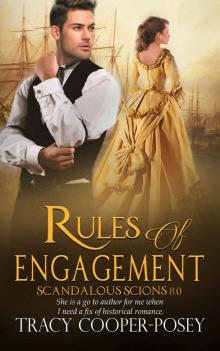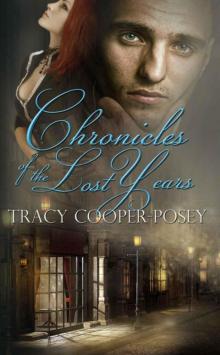- Home
- Cooper-Posey, Tracy
Chronicles of the Lost Years (The Sherlock Holmes Series)
Chronicles of the Lost Years (The Sherlock Holmes Series) Read online
•ï¡÷¡ï• •ï¡÷¡ï• •ï¡÷¡ï•
_______________________________________
• Chronicles •
of the
• Lost Years •
________________________________________
•ï¡÷¡ï• •ï¡÷¡ï• •ï¡÷¡ï•
by
Tracy Cooper-Posey
A Stories Rule Publication
When Sherlock Holmes was at the peak of his success he disappeared, abruptly, for three years. Dr. Watson believed him to be dead. No one knows what happened to him in those years…until now.
Watson takes up his pen one last time to describe in a private memoir the true tale of Holmes’ adventures during his three-year absence from Baker Street and provides a fictional explanation for many of the mysteries and inaccuracies found within the Sherlock Holmes collection of stories and novels.
The answers come in the shape of a woman – Elizabeth Sigerson. Elizabeth is independent, practical, a crack shot with a pistol and definitely not a woman of her time. Elizabeth is embroiled in Holmes’ life just when Holmes scheme to expose Moriarty is culminating. She can more than hold her own against Holmes’ abilities but she has a secret that Holmes is compelled to solve…
•ï¡÷¡ï• •ï¡÷¡ï• •ï¡÷¡ï•
Praise for
• Chronicles of the Lost Years •
_________________________
•ï¡÷¡ï•
This one, yet another account of the Great Hiatus, when Holmes hid out from the infamous Moriarty, is better than most. Cooper-Posey attempts to account for the change in Watson/Conan Doyle’s writing style once Holmes returns, and does a mighty good job.
Margaret Cannon for The Globe and Mail
Cooper-Posey does a masterful job of recreating the style of Doyle in this vivid, exciting tale.
Toby Bromberg for Romantic Times Magazine
STORIES RULE PUBLICATIONS
A sole proprietorship owned and operated
by Tracy Cooper-Posey
This is an original publication of Tracy Cooper-Posey
This is a work of fiction. Names, characters, places and incidents either are the product of the author’s imagination or are used fictitiously, and any resemblance to actual persons, living or dead, business establishments, events, or locales, is entirely coincidental. The publisher does not have any control over and does not assume any responsibility for third-party websites or their content.
Copyright © 2013 by Tracy Cooper-Posey
Text design by Tracy Cooper-Posey
Cover design by Dar Albert
Wicked Smart Designs
http://wickedsmartdesigns.com
All rights reserved
No part of this book may be reproduced, scanned, or distributed in any printed or electronic form without permission. Please do not participate in or encourage piracy of copyrighted materials in violation of the author’s rights. Purchase only authorized editions.
FIRST EDITION: March 2000
SECOND EDITION: December, 2012
Cooper-Posey, Tracy
Chronicles of the Lost Years/Tracy Cooper-Posey—2nd Ed.
1. Suspense—Fiction 2. Romantic Suspense 3. Mystery 4. Sherlock Holmes 5. Dr. John Watson 6. Baker Street 7. Victorian London 8. Sir Arthur Conan Doyle 9. The Great Hiatus, Moriarty 10. The Final Problem
• Chronology of Events •
_________________________
•ï¡÷¡ï•
(Events particular to Watson’s last chronicle are in italics)
1878
Watson graduates as Doctor of Medicine—London University
Second Afghan war begins
Watson travels to Bombay
Date uncertain—events of “The Adventure of the Gloria Scott”—Holmes’ first case, while still in college.
1880
Battle of Maiwand—Watson received his wound in the shoulder (which later became a wounded leg)
Two unnamed cases while Holmes was living in Montague Street.
Year uncertain—the events of “The Adventure of The Musgrave Ritual”—third case in Montague Street.
1881
Watson returns to London, meets Sherlock Holmes, and together they move into 221B Baker Street.
October—the events of “The Adventure of the Resident Patient.”
1882
March 4 (year imprecise)—events of “A Study in Scarlet,” Watson’s first introduction to Holmes’ work.
Events of the Trepoff Murder case in Odessa—a case mentioned in passing by Watson.
Events of the case of the Atkinson Brothers at Trincomalee—a case mentioned in passing by Watson.
Events of the Case concerning the Royal family of Holland—a case mentioned in passing by Watson.
1883
Early April—the events of “The Adventure of the Speckled Band.”
Date uncertain—the events of “The Adventure of Silver Blaze”—Watson living at Baker Street.
Early spring (year uncertain—the events of “The Adventure of the Yellow Face”—Watson living at Baker Street.
August (year uncertain)—the events of “The Adventure of the Cardboard Box”—Watson living at Baker Street
Summer (year uncertain)—the events of “The Adventure of the Greek Interpreter.”
October (year uncertain)—the events of The Hound of the Baskervilles.
1887
February (year uncertain—Watson still living at Baker Street)—the events of “The Adventure of the Beryl Coronet.”
April 14—Holmes falls ill in Lyon, from overwork. Watson summoned.
April—the events of “The Adventure of the Reigate Squire.”
July 7/September (both months are mentioned.) Year uncertain, might be 1886—the events of “The Sign of Four.”
Autumn—the events of “The Adventure of the Noble Bachelor.”
(Month uncertain)—Watson’s marriage to Mary Morston
Late September—the events of “The Five Orange Pips,”—in the story Watson says his wife is visiting her mother, yet his wife (Mary Morston, who he met in the case of “The Sign of Four”) is an orphan.
Events of the Adventure of the Paradol Chamber—a case referred to by Watson, but never written up.
Events of the British barque “Sophy Anderson”—a case referred to by Watson, but never written up.
Events of the Camberwell poisoning—a case referred to by Watson, but never written up.
1888
March (year uncertain)—Watson buys medical practice in Paddington.
July—first of two possible dates for the events of “The Adventure of the Norwood Builder”—Hilton Cubitt refers to the Jubilee of the previous year, and Watson is living at Baker Street (which is anachronistic for both possible dates—see 1889). Logically this is the more likely year, for if Cubitt had been referring to the second Jubilee, it would have been natural for him to qualify that he meant the second Jubilee, not the first.
20th March—events of “A Scandal in Bohemia.”
Summer—the events of “The Adventure of the Crooked Man”—shortly after Watson’s marriage.
June 3, Monday (year uncertain)—the events of “The Boscombe Valley Mystery.”
June (year uncertain)—the events of “The Adventure of the Stockbroker’s Clerk”—Watson dates this case three months after the purchase of his private practice.
July—the events of “The Adventure of the Naval Treaty,”—occurs in “the July which immediately succeeded my marriage” (Watson).
July—the events
of “The Adventure of the Second Stain”—in this story, Watson state that the case’s international ramifications mean that the year and date should remain vague. Yet he states the year and the month in passing reference in an earlier story as July, 1888. This is contradicted in the actual story, in which Watson states the events occur in autumn. Assumed that Watson is attempting to misdirect.
July—the events of “The Adventure of the Tired Captain.”
1889
Early Spring (year uncertain)—the events of “The Adventure of the Copper Beeches”—In this case, Watson appears to be living at Baker Street, which would place the date as pre-1887, yet Holmes talks about the cases of “A Scandal in Bohemia” and “A Case of Identity.” Assumed Watson is a temporary guest.
Friday, June 19th—the events of “The Man with the Twisted Lip”—Watson’s wife calls him “James”. It is from the slip that it has been established that John Watson’s second initial must stand for Hamish, which is Scottish for James.
Summer—the events of “The Adventure of the Engineer’s Thumb.”
December 27 (year uncertain)—the events of “The Adventure of the Blue Carbuncle.”
November—the events of “The Adventure of the Dying Detective”—occurred in the second year of Watson’s marriage.
Year uncertain—events of “The Valley of Fear”—Watson states it is the end of the ‘eighties.
1890
Month uncertain—events of “A Case of Identity.”
June—Events of “The Red-Headed League.”
1891
Holmes in France working for French Government
January 4—Holmes “crossed swords” with Moriarty.
January 23—Holmes “incommoded” Moriarty.
Mid February—Moriarty “seriously inconvenienced” by Holmes.
Friday April 24—the events of “The Adventure of the Final Problem*”:
- (a.m.) Moriarty visits Holmes
- (p.m.) Holmes visits Watson
- Saturday April 25: Moriarty visits Homes—a.m.
- Sunday April 26: Travel to Brussels
- Monday April 27: Brussels—Holmes telegraphs London police
- Travel to Strasbourg
- Evening—away reply
- Move on toward Geneva
- Tuesday April 28—Sunday May 3
- Travel up the Rhone Valley to Leuk
- Across the Gemmi Pass (in snow) along the Daubensee, through Interlaken to Meirengen
- Sunday May 3: Stay at Englischer Hof., Meirengen
- Monday May 4: Intend to cross the hill and spend the night at Rosenlaui
- Stop off at the Reichenbach Falls. There the Swiss boy delivers the message which sends Watson back down the hill to Meirengen.
- Moriarty confronts Holmes.
The events related in The Chronicles of the Lost Years begin.
1892
Late March—the events of “The Singular Experience of Mr. John Scott Eccles (‘A Reminiscence of Mr. Sherlock Holmes’).” Perhaps because it was reminiscence, Holmes can be forgiven for getting his dates wrong—he was in Tibet at the time he claims this case took place.
1893
December—Colonel James Moriarty writes a report which causes Watson to respond with his story of Holmes’ confrontation with Moriarty at Reichenbach—publication of “The Adventure of the Final Problem.”
1894
March 30th—the events of “The Adventure of the Empty House*.”
Date uncertain—the events of the case of the Papers of the ex—resident Murillo—a case merely referred to in passing, but not written up.
Date uncertain—the events of the case of the Steamship “Friesland”—a case merely referred to in passing, but not written up.
Summer (?)—date uncertain—the events of “The Adventure of the Norwood Builder”—Watson writes that “Holmes had been back for some months” and refers to the above two cases.
Late November—the events of “The Adventure of the Golden Pince-Nez.”
1895
February (year uncertain)—the events of “The Adventure of the Missing Three—Quarter.”
Saturday April 23—the events of “The Adventure of the Solitary Cyclist.”
Month uncertain, but prior to July—events of the case of the death of Cardinal Tosca—referred to by Watson, but not written up.
Month uncertain, but prior to July—events of the case of Wilson, the Canary trainer—referred to by Watson, but not written up.
July (1st week)—the events of “The Adventure of Black Peter.”
November, 3rd week—the events of “The Adventure of the Bruce-Partington Plans.”
Date uncertain—winter—the events of “The Adventure of Charles Augustus Milverton.”
Month uncertain—the events of “The Adventure of the Six Napoleons.”
Date uncertain—the events of “The Adventure of the Three Students.”
1896
Early in year—the events of “The Adventure of the Veiled Lodger.”
1897
March—events of “The Adventure of the Devil’s Foot”—Holmes is forced to take a holiday in Cornwall because of ill health.
Winter (month uncertain)—the events of “The Adventure of the Abbey Grange.”
1898
Tuesday May 14 (year uncertain)—the events of “The Adventure of the Priory School”—This is the earliest possible date, for Lord Holderness was married in 1888 and his son, the subject of the case, was ten years old.
July—second of two possible dates for the events of “The Adventure of the Norwood Builder” (See 1888).
1899
Summer—month uncertain—events of “The Adventure of the Retired Colourman.”
1902
Late June—the events of “The Adventure of the Three Garridebs.”
September 3—the events of “The Adventure of the Illustrious Client.”
Early September—the events of “The Adventure of the Creeping Man.”
1903
January—the events of “The Adventure of the Blanched Soldier.” Holmes himself related this tale, although it wasn’t published in The Strand until over a decade later.
Month uncertain—Holmes retires to the Sussex Downs to study and indulge in bee-keeping.
1907
July—events of “The Adventure of the Lion’s Mane” (after retirement, in Sussex). This is the second case Holmes narrates himself.
1915
August 2—the eve of World War I—the events of “His Last Bow.” The reunion of two old friends.
Watson joins old service (Fifth Northumberland Fusiliers), shortly after this case.
____
Undated cases:
“The Adventure of Shoscombe Old Place” (Watson at Baker Street)
“The Adventure of the Red Circle”
“The Disappearance of Lady Frances Carfax” (After Crimean war)
“The Adventure of the Three Gables”
(Summer)—”The Mazarin Stone” (Watson not at Baker Street)
November—”The Adventure of the Sussex Vampire”
October—”The Problem of Thor Bridge” (Watson at Baker Street)
*Both “The Adventure of The Final Problem” and “The Adventure of The Empty House” are included in this book as a bonus. Continue reading at the end of Chronicles of the Lost Years.
• Chapter One •
_________________________
•ï¡÷¡ï•
Queen Anne Street, December 1903
IT WILL COME as a considerable shock to readers who know Sherlock Holmes only through my writings in The Strand magazine that my assertion that he was unique and certainly the most fascinating of subjects was fraudulent. There was another I knew—as equally as fascinating an individual. Her name was Elizabeth Sigerson.
It would seem appropriate that these two highly individual people should meet and indeed they did, in the spring of 1891 when Holmes was expending n
early all his energy in the final battle of wits with Moriarty.
Because of the omission of facts I have given the public concerning my very singular friend Sherlock Holmes, I feel I should complete the record here and if by some chance this memoir comes to light in a distant time, then so be it.
To begin at the beginning and include all the facts I must go back to the winter of the year 1891.
Winter of that year was unruly and unpredictable and I cannot recall another season that was so out of character as that year’s. Experts spoke of magnetic fluxes about the globe and the more common folk pondered the unusual arrays of temperature and the truly remarkable extremes. Record levels of snow would fall for two days, then unseasonable days of sunshine would turn the falls to floods.
The weather appeared to affect every person’s temperament and the number of crimes rose to an astonishing level. Sherlock Holmes was busy investigating numerous mysteries and would often of an evening arrive at my fireplace to bemoan the sheer quantity of his work and its correspondingly poor quality. Always he remarked on the common underlying cause of each motivation.

 Heart Strike
Heart Strike Degree of Solitude
Degree of Solitude Kiss Across Blades
Kiss Across Blades Rules of Engagement
Rules of Engagement Marriage of Lies
Marriage of Lies More Time Kissed Moments
More Time Kissed Moments Hunting The Kobra
Hunting The Kobra Black Heart
Black Heart Eva's Last Dance
Eva's Last Dance Solstice Surrender
Solstice Surrender Inconvenient Lover
Inconvenient Lover Lucifer's Lover
Lucifer's Lover Wait (Beloved Bloody Time)
Wait (Beloved Bloody Time) Diana by the Moon
Diana by the Moon Delly's Last Night (Go Get 'Em Women)
Delly's Last Night (Go Get 'Em Women) Heart of Vengeance
Heart of Vengeance Law of Attraction
Law of Attraction Southampton Swindle
Southampton Swindle Chronicles of the Lost Years (The Sherlock Holmes Series)
Chronicles of the Lost Years (The Sherlock Holmes Series) V-Day
V-Day Kiss Across Time (Kiss Across Time Series)
Kiss Across Time (Kiss Across Time Series) Vale: A Short Erotic Vampire Romance Story
Vale: A Short Erotic Vampire Romance Story Dead Again: A Romantic Thriller
Dead Again: A Romantic Thriller Dangerous Beauty
Dangerous Beauty Blood Knot
Blood Knot Vivian's Return
Vivian's Return Veil of Honor
Veil of Honor Perilous Princess: A Sexy Historical Romance
Perilous Princess: A Sexy Historical Romance Dead Double
Dead Double Broken Promise
Broken Promise Royal Talisman
Royal Talisman